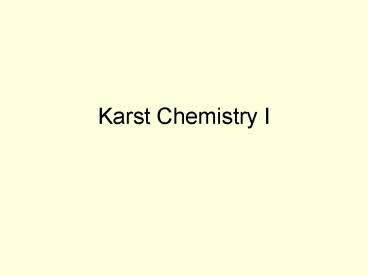Karst Chemistry I
1 / 26
Title: Karst Chemistry I
1
Karst Chemistry I
2
Definitions of concentration units
- Molality m moles of solute per kilogram of
solvent - Molarity x moles of solute per kilogram of
solution - Molarity
- Parts per million (ppm) weight of solute per
million weight of solution (i.e. mg/L) - 1 1 part per hundred or 10,000 ppm
- Milliequivalent (meq) mg/L / equivalent weight
- Milligram equivalents per kilogram
- (epm) ppm / equivalent wt.
3
Basic Karst Chemistry
- Global Equation for weathering of limestone
- CaCO3CO2H2O?Ca22HCO3-
- This equation comprises three different attacks
on the calcite surface - Carbonic Acid
- Water
- Other acids
4
Dissociation
- In the presence of water Calcite will dissociate
- CaCO3?Ca2CO32-
- This reaction is described by solubility product
constant - Where a is the activity of the dissolved species
and is closely related to concentration. - The solubility product is a function of
temperature.
5
(No Transcript)
6
Dissociation (cont.)
- The carbonate ions that form by the dissociation
hydrate when in contract with water - CO32- H2O? HCO3-OH-
- H2O?H OH-
- CO32- H OH- ? HCO3-OH-
- This forms a mildly alkaline solution, raising
the pH and decreasing the carbonate solubility,
which is low in water.
7
Acid Dissolution Carbonic Acid
- Most carbonate minerals are readily soluble in
acid - The acid most important to karst processes is
carbonic acid (H2CO3), formed by the dissolution
of gaseous CO2 - CO2(g)? CO2(aqueous)
- CO2(aqueous)H2O?H2CO3
8
Acid Dissolution Carbonic Acid (cont.)
- This reaction is described by equilibrium
constant - Where PCO2 is the carbon dioxide partial pressure
expressed in atmospheres. - What happens to the concentration of dissolved
CO2 as the carbon dioxide pressure changes?
9
(White, 1988)
10
- Neutral carbonic acid dissociates in solution to
form the bicarbonate ion, which in turn
dissociates to form the carbonate ion. - H2CO3 ?HCO3-H
- HCO3- ?CO32-H
- At the pH and Ionic strength of most
carbonate-bearing waters, which ion species is
dominate?
11
Bjerrum Plot
12
- The previous reactions are described by
equilibrium constants
13
- The ionization of carbonic acid releases hydrogen
ions, forming a mildly acid solution. - The connection between these reaction and the
hydration of the carbonate ion formed by
dissociation of carbonate minerals is the
dissociation of water - H2O?H OH-
- With
- The activity of the carbonate ion links these
reactions to the solubility of calcite and
dolomite. - The activity of carbonic acid ties the system to
the external carbon dioxide pressure.
14
- The net reaction for dissolution of calcite by
carbonic acid is - CaCO3CO2H2O?Ca22HCO3-
15
(No Transcript)
16
(No Transcript)
17
Activity coefficients
- The equilibrium constants for these various
reactions are written in terms of activities of
the constituent species. - Only the H activity is determined experimentally
by measuring pH - Other ions are determined experimentally as
concentrations, since concentration is related to
activity by the expression - aigimi
- where mi is molal concentration (moles of solute
per liter of solution).
18
Activity coefficient, gi
- gi connects the activity (a thermodynamically
idealized concentration) with the idealized
concentration. - The gi can be calculated using the Debye-Hückel
equation
19
- Parameters A and B are constant for a given
temperature and for a given solvent
Values for A and B for aqueous solutions (Manov
et al., 1943)
20
- zi is the formal charge on the ion and åi is a
parameter specific to each ion that effectively
measures ionic diameter.
Values for åi (Garrels and Christ, 1965)
21
Ionic Strength (I)
- I is a measure of the total concentration of
charged species in solution, whether or not these
species take part in the reactions under
consideration - The equation is valid up to ionic strengths of
about 0.1, it is generally adequate for karst
waters
22
- In most karst waters there will only be seven
constituents in significant concentration. - In most areas Na, K, Cl-, and SO42- can be
neglected, but the should be measured to be sure. - Rule of thumb I for brackish water 0.1 and
for fresh water 0.01
23
Measurements
- Characterization of karst waters requires certain
chemical analyses and measurements - pH
- Temperature
- Conductivity
- Cation Anion concentrations
- Alkalinity
- If possible CO2 in the gas phase
24
pH
- The hydrogen ion activity is expressed as pH
(pH-log aH) - Can be measured directly with a pH meter
25
Temperature
- The temperature of karst waters can be very
stable, a change of 0.1 ºC can reveal a
meaningful fluctuation. Other systems can be
highly variable.
26
(No Transcript)































